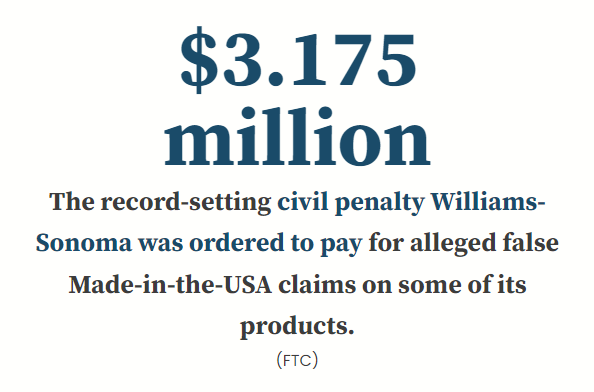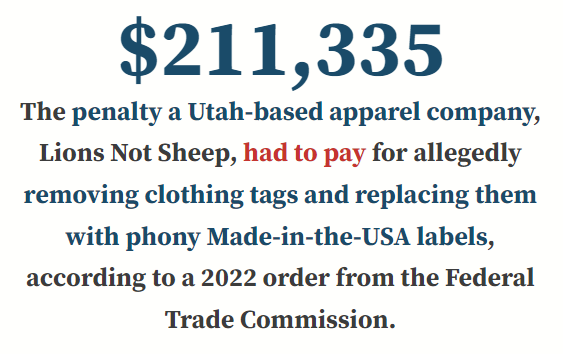Williams-Sonoma notched a record-breaker, but for all the wrong reasons.
In April, the Federal Trade Commission (FTC) slapped the retailer of kitchenware and home furnishings with what is reportedly the largest ever civil penalty related to alleged false Made-in-the-USA claims – $3.175 million.
The FTC determined that Williams-Sonoma had been advertising certain products as American-made when in fact they were manufactured in China and other countries, all in violation of a 2020 FTC order tied to earlier allegedly fraudulent U.S.-origin claims by the company.
The federal chastening followed fast after a case that had marked an all-time record for a civil penalty stemming from reportedly bogus USA-made labeling. In January 2024, Kubota North America Corporation agreed to pay a $2 million fine for labeling replacement parts for tractors and other agricultural equipment as Made in the USA, even though they were produced overseas.
The recent cases highlight that the FTC is pressing enforcement of rules regarding Made-in-the-USA assertions – a reality about which companies in the promotional products industry would be wise to take heed. Clearly, violating rules can result in sizable civil penalties and other headaches – such as having to submit annual compliance certifications to the FTC, as Williams-Sonoma must now do.
Some promo leaders ASI Media spoke with maintain that mislabeling or incorrectly advertising products as American-made, when in fact the items don’t meet the standard to be designated as such, is a problem in many industries, including the merch market.
“It’s an issue across our industry,” shares an executive at a Top 40 supplier who wished to remain anonymous.
Whether done as willful deception or out of ignorance, such false claims ultimately deceive would-be buyers and give the product purveyors an unfair advantage in a domestic marketplace in which end-clients often would prefer to purchase American-produced products, provided the price is right, critics say.
But just what does it mean to be Made in the USA? What standards must be met? What’s a qualified claim? And is there a difference between Made in the USA and Assembled in the USA? While not a substitute for legal advice, this ASI Media Q&A primer helps answer those questions.
Q: When can a product be labeled/marketed as “Made in the USA” under federal rules?
A: For a product to be called Made in the USA, or to claim to be of domestic origin without qualifications or limits on the claim, it must be “all or virtually all” made in the United States. This means the final assembly or processing of the product occurs in the U.S., all significant processing that goes into the product happens here and all or virtually all ingredients or components of the product are made and sourced domestically. “The product should contain no – or negligible – foreign content,” says Mitchell J. Katz, a senior public affairs specialist at the FTC.
Federal rules on Made in the USA apply to claims on products themselves and labeling, as well as in advertising and marketing materials, including digital platforms like web-based ads, emails, social media and online product descriptions.
Heads Up: The FTC says that manufacturers and marketers should not indicate, either expressly or implicitly, that a whole product line is of U.S. origin when only some products in the collection are produced domestically.
Q: How does the FTC determine if the “all or virtually all” standard is met when it comes to product parts?
A: Katz says there’s no “bright-line percentage” of a product’s ingredients/components that the FTC says must be produced/sourced domestically for an item to be called Made in the USA. Rather, the FTC considers elements like how much of a product’s total manufacturing costs can be assigned to U.S. parts and processing, how far removed any foreign content is from the finished product and how important a role internationally produced components are to a product’s form or function.
Things can get tricky, and sometimes, the form or function factors supersede cost in relevance to the FTC assessment.
The FTC gives an example in which a watch is produced in the U.S. with American labor and mostly U.S. parts, but the company uses foreign-origin movement components in the watches. The movements may not be a big percentage of the product’s production cost, but without them, the watches won’t work. “Because movements are essential to the watches’ function, an unqualified Made in USA claim is likely deceptive,” the FTC says.
Q: Is FTC approval required to market as Made in the USA?
A: A company doesn’t need approval from the FTC before making a Made-in-the-USA claim, and the FTC doesn’t preapprove advertising or labeling claims. Still, the commission advises manufacturers and marketers to be prepared to substantiate their U.S.-made assertions based on reasonable evidence that shows a product truly meets the “all or virtually all” standard.
Ample documentation can prove helpful in this regard and is something Counselor Top 40 supplier Koozie Group (asi/40480) says it takes seriously.
“We require our vendors to fill out certificates stating that the product is Made or Assembled in USA before we will make any USA-related claims on an item,” says Victoria Sierra, compliance manager at Koozie Group. “The certificate itself refers to the Federal Trade Commission’s Truth in Advertising guidelines and California’s False Advertising Act, so our vendors know the specific standards upon which we are basing the certificate’s claim.”
Additionally, Koozie Group asks vendor partners to fill out certifications for individual components of a product that Koozie Group produces itself. “For example, we manufacture Souvenir Sticky Note products in-house, but we don’t manufacture the ‘sticky’ adhesive,” Sierra shares. “Because we source this component, we ask our supplier to fill out this certificate for that one component so we can ensure that our Made in USA claim is valid and the correct claim for the product.”
The FTC says that, if given in good faith, manufacturers and marketers can rely on information from vendor partners about the domestic content in the parts, components and other elements they produce and advertise. “Rather than assume the input is 100% U.S.-made, however, manufacturers and marketers would be wise to ask the supplier for specific information about the percentage of U.S. content before they make a U.S. origin claim,” the FTC states.
Q: What’s a qualified claim?
A: “Made in the USA From Chinese Parts.” “Designed in USA & Manufactured in Thailand.” “80% U.S. Content.”
These are examples of qualified claims – assertions on products, labels and in marketing/advertising/descriptions that share the extent, amount or type of a product’s domestic content or processing. They indicate a product isn’t completely of domestic origin, as would be the case with an unqualified claim of simply “Made in the USA.”
A qualified claim must feature a verifiable, clear and conspicuous disclosure about the extent to which the product contains foreign parts, processing and/or ingredients or components.
“Qualified USA claims are becoming more popular,” shares Sierra. “It’s because American customers want to see a USA connection to the product, but companies don’t want to violate the FTC’s guidelines.”
Even so, manufacturers and marketers can still run afoul of regulators with qualified claims and must tread carefully to avoid stating or implying more domestic content or production than was actually used to produce a product.
“Avoid qualified claims unless the product has a significant amount of U.S. content or U.S. processing,” the FTC advises. “A qualified Made in USA claim, like an unqualified claim, must be truthful and substantiated.”
Heads Up: It may be smart to avoid using a term like “Created in the USA,” unless a product meets the criteria for an unqualified Made-in-the-USA assertion. Say, for instance, a new tote bag is designed in Colorado but then actually produced in India. Calling this product “Created in the USA” would likely be considered deceptive by the FTC, as commission officials may conclude there’s a high likelihood that consumers would equate “created” with “made,” which indicates domestic manufacturing from largely domestic components. A qualified claim like “Designed in USA & Manufactured in India” would probably be more appropriate.
Q: Is there a difference between “Made in the USA” and “Assembled in the USA”?
A: Yes, though it’s often misunderstood, experts say. “A lot of people think these claims mean the same thing, but they’re relaying different information,” Sierra shares.
A product can be called Made in the USA without qualification when it meets the domestic production and the “all or virtually all” product component criteria. In laymen’s terms, Assembled in the USA means that a product contains a higher degree of foreign components but that its primary assembly occurs within the United States and that this assembly is substantial.
Again, the devil is often in the details.
An FTC example: Say a lawn mower composed of mostly domestic parts, except for the cable sheathing, flywheel, wheel rims and air filter, is built in the U.S. It’s copacetic to call that product Assembled in the USA, the FTC says. However, take a computer in which all the major components are made overseas but then cobbled together domestically – that’s a case in which an unqualified Assembled-in-the-USA claim would likely be deceptive because the parts are primarily foreign and because stateside assembly wasn’t substantial, according to the FTC.
“A simple ‘screwdriver’ assembly in the U.S. of foreign components into a final product at the end of the manufacturing process doesn’t usually qualify for the Assembled in USA claim,” the FTC states.
Heads Up: Due to certain laws, U.S. content must be disclosed on products such as automobiles, textiles, wool and fur items. Still, there’s no law that requires most other products sold in the U.S. to be marked or labeled Made in the USA or have any other disclosure about their amount of U.S. content. It’s up to companies if they want to share such information.
Q: How can promo get better on Made-in-the-USA claims?
A: For starters, suppliers, distributors and end-buyers can dig deeper into educating themselves about the various types of USA-made claims, what they mean and where they can be applied. “Study the FTC guidelines,” says Sierra.
Further, suppliers should have a dedicated compliance manager/legal expert review Made-in-the-USA assertions, including qualified claims and “assembled-in” claims, before putting them on products, labels or in marketing/advertising.
Greater transparency, backed by good documentation, and improved distributor due diligence could help, too. “Suppliers can be more forthcoming about how they validated a USA-related claim, and distributors and end-users can ask for that validation if it’s not provided,” Sierra shares.
Koozie Group, Sierra says, has made certificates on its USA-related claims available on its website product pages. “Our goal,” she says, “is to make this information easy to find and to be open with our distributors.”





